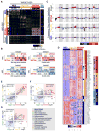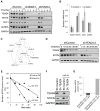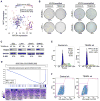Cross-Cohort Analysis Identifies a TEAD4-MYCN Positive Feedback Loop as the Core Regulatory Element of High-Risk Neuroblastoma
- PMID: 29510988
- PMCID: PMC5967627
- DOI: 10.1158/2159-8290.CD-16-0861
Cross-Cohort Analysis Identifies a TEAD4-MYCN Positive Feedback Loop as the Core Regulatory Element of High-Risk Neuroblastoma
Abstract
High-risk neuroblastomas show a paucity of recurrent somatic mutations at diagnosis. As a result, the molecular basis for this aggressive phenotype remains elusive. Recent progress in regulatory network analysis helped us elucidate disease-driving mechanisms downstream of genomic alterations, including recurrent chromosomal alterations. Our analysis identified three molecular subtypes of high-risk neuroblastomas, consistent with chromosomal alterations, and identified subtype-specific master regulator proteins that were conserved across independent cohorts. A 10-protein transcriptional module-centered around a TEAD4-MYCN positive feedback loop-emerged as the regulatory driver of the high-risk subtype associated with MYCN amplification. Silencing of either gene collapsed MYCN-amplified (MYCNAmp) neuroblastoma transcriptional hallmarks and abrogated viability in vitro and in vivo Consistently, TEAD4 emerged as a robust prognostic marker of poor survival, with activity independent of the canonical Hippo pathway transcriptional coactivators YAP and TAZ. These results suggest novel therapeutic strategies for the large subset of MYCN-deregulated neuroblastomas.Significance: Despite progress in understanding of neuroblastoma genetics, little progress has been made toward personalized treatment. Here, we present a framework to determine the downstream effectors of the genetic alterations sustaining neuroblastoma subtypes, which can be easily extended to other tumor types. We show the critical effect of disrupting a 10-protein module centered around a YAP/TAZ-independent TEAD4-MYCN positive feedback loop in MYCNAmp neuroblastomas, nominating TEAD4 as a novel candidate for therapeutic intervention. Cancer Discov; 8(5); 582-99. ©2018 AACR.This article is highlighted in the In This Issue feature, p. 517.
©2018 American Association for Cancer Research.
Conflict of interest statement
Dr. Califano reports the following Conflict of Interest. He is a founder and equity holder in DarwinHealth Inc., a company that has exclusively licensed the VIPER algorithm used in this manuscript from Columbia University. Columbia University also has a commercial interest in DarwinHealth Inc.
Figures






References
-
- Molenaar JJ, Koster J, Zwijnenburg DA, van Sluis P, Valentijn LJ, van der Ploeg I, et al. Sequencing of neuroblastoma identifies chromothripsis and defects in neuritogenesis genes. Nature. 2012;483(7391):589–93. - PubMed
Publication types
MeSH terms
Substances
Grants and funding
LinkOut - more resources
Full Text Sources
Other Literature Sources
Medical
Molecular Biology Databases
Research Materials

